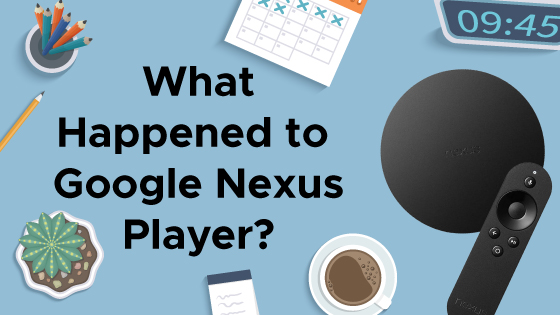Google’s Nexus Player, launched in 2014, was a quick follow up to Google’s first Android TV success with the Chromecast. The now-discontinued Nexus player was a streaming device launched to compete with Amazon’s Fire Stick and Roku 2.
On the heels of Google’s first successful streaming device, Chromecast, the Nexus player was supposed to be Google’s answer to the next generation of Android TV devices. While the player did have some initial success, it had some limitations that caused many users to move on to more capable devices.
What is Google’s Nexus Player
Google’s Nexus Player is a media player used for streaming content to a television. At the time of its release in 2014, this device was fitted with an 802.11 chip to deliver the fastest internet connection for fast, reliable streaming.
The Nexus Player was developed as part of a collaboration between Google, Intel, and Asus. Google was the big name behind the Nexus player; they put all of their weight behind pushing the product and leveraged their own portfolio of services to integrate search and apps within the device.
Intel provided the processor. The Nexus player came with a 1.8 GHz Quad-core Intel Atom processor. At the time of its release, this was considered a powerful, gaming-friendly processor. It was a good choice for Google’s multi-functional media device.
Asus was an up and coming computer manufacturer at the time of development. Since then, the company has grown to a meaningful market share in digital products like computers and tablets. The Nexus player included the streaming device, a remote, and an optional gamepad.
The Nexus player saw initial success thanks to its intuitive and easy to navigate interface. But its success was short-lived due to humble storage capacity and a lack of available apps. Competitors like Amazon’s fire stick offered users unlimited cloud storage and 2GB of RAM.
With 8 GB of storage and 1 GB of RAM, the Nexus player was quickly passed over by serious users who simply needed more bandwidth than the device could offer. In 2016, just two years after its release, the Google Nexus player was quietly discontinued.
Features of Google’s Nexus Player
In addition to a more-than-capable processor and an 802.11 chip that allowed for fast internet delivery, Google’s Nexus player had several attractive features.
Stream Music and Video
Starting with the most basic, the Nexus player was capable of streaming music and video to a television. When paired with an appropriate internet connection, it could deliver content quickly without buffering.
Casting to Other Devices
One of the unique features that the Nexus player offered was the Chromecast technology to cast media on to other devices like televisions, tablets, or smartphones. Customers who enjoyed the Chromecast were pleased with this feature.
Content Sync Across Devices
Syncing is a particularly helpful feature for homes that utilize multiple devices. Users can begin watching a movie on one device and then pick up in the same spot at a later time on another device.
Android Gaming on the Big Screen
With the purchase of the optional Nexus gamepad, a remote controller designed for use with Google’s Nexus player, users can bring Android gaming to their big-screen televisions. The processor and internet speeds are very capable of gaming, but some users found the storage capacity to be lacking.
Voice Search
This device was fairly early in the voice search game. For its time, it performed aptly using Google’s voice search technology. Users were often frustrated, though, with its limitations. Users would have to ask queries in the way that the voice search was programmed to recognize them, or they would get poor results.
If you are comparing Google’s Nexus player to the streaming technology available in 2020, current technology will outperform this device in every category. But, at the time of development, it had several new and robust features. A recommendation algorithm and voice search were among those features.
What Led to the Downfall of Google’s Nexus Player
While the Nexus player was a solid effort at keeping up with the streaming device game, its momentum fell flat in a few key areas. With better options available on the market, consumers quickly shifted away from the Nexus player. Admitting defeat, Google discontinued the player in 2016 and ended all support in 2018.
Limited Storage
Google’s Nexus player offered 8 GB of internal storage. Even in 2014, this was only a modest amount of storage. The device did offer the ability to use external storage, but compared to Amazon’s unlimited cloud storage; this was still too cumbersome for many users.
Limited Search Function
Google seems to have heavily favored their own content in the search algorithms. Both the search function and the voice search function seemed to heavily favor Google content in search results. This felt a little too boxed in for many users.
Slow and Buggy Software
Compared to competitors like Roku and Fire Stick, the Nexus player just didn’t measure up to expectations in the user experience. The device was slow to switch between apps and often buggy.
What’s Next for Nexus Player Owners
In 2014, nearly 7.6 million households were using streaming devices. Despite this large number, streaming devices and smart TV’s were still new. There was a lot of unchartered territory being explored by big names like Google, Amazon, and Roku.
Google’s Nexus Player was officially discontinued in 2016, and the company ended support in 2018. By late 2018, many users had started reporting that their devices were inoperable. Anyone still using a Nexus player may be trading off for not updating their browsers. At the $50-$150 range, it is worthwhile to invest in a newer device.
While Google does not have a set-top box on the market right now, they are the ones behind Android TV, so they will always be involved in the game – as long as Android TV is still relevant.
What is Android TV
Android TV is an Android-based operating system that is designed specifically for streaming content to a television through the use of a set-top box, dongle, soundbars, and smart TV’s. This operating system was first launched in 2014 with the Nexus Player but has continued to evolve beyond the capabilities of that player.
Today, the Android TV operating system is utilized to select smart TV models from brands like Sony, Hisense, and Philips. Or, on set-top boxes like Nvidia connected through an available HDMI port. While Amazon’s Fire TV uses an Android platform as well, it is not the same as Android TV devices.
Android TV is an Android-based operating system that has been optimized for use with televisions. Instead of opening a screen and seeing a menu of app icons like you would on an Android mobile device, Android TV shows the user-curated content designed for TV viewings like movies and videos.
Amazon used Android’s open-source operating system to create its own Fire OS. This allows Amazon to add features that are specifically compatible with their devices and services. While both are technically Android-compatible, Android TV and Fire TV are two distinctly separate operating systems.
Android TV Devices for 2020
Despite the downfall of Google’s Nexus Player, Android TV is still a popular operating system for streaming devices. If you are looking to upgrade to the latest technology and want to stay on the Android TV platform, there are several great options.
For Gaming & Streaming
For an all-immersive, stunning visual experience, the NVIDIA Shield TV runs on the Android TV operating system. It is built for the most intensive users. Thanks to a processor upgrade, the NVIDIA Shield TV is now 25% faster than older models. For gaming and viewing pleasure, it offers Ultra 4K in Dolby HDR with Dolby Atmos sound.
Compact and Budget-friendly
The Xiaomi Mi Box S retails for $40 (compared to NVIDIA’s $150 price tag) and measures up to all the specs for streaming video. It offers 4K HDR with full access to the Google Play Store and Google Cast abilities. It is a great choice for budget-friendly, casual streamers.
Solid Middle-of-the-Road Option for Netflix Users
Choosing the right streaming device really depends on how you will use it. That is, what specific apps or services you will utilize on the device. Thanks to Digital Rights Management licensing, you have to have the right certificates in order to get the best quality video streams from different services.
Ematic’s Jetstream is one of the few Android TV set-top boxes to come with Netflix certification. For a $70 price point, it offers 4K UHD streaming at a good price.
Again, What Happened to Google’s Nexus Player?
In a word – it became obsolete. What launched as the premier device to deliver Android TV to your television quickly fell flat of consumer expectations. After two years on the market, it was pulled from the shelves. The competition from Amazon Fire TV and Roku simply outperformed this device.
Google regrouped and turned its focus on developing the Android TV operating system so that it could be used on all kinds of devices from Sony TV’s to NVIDIA set-top boxes.




